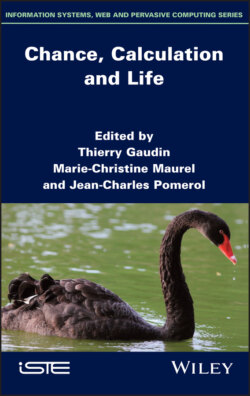Читать книгу Chance, Calculation and Life - Группа авторов - Страница 20
1.6. Classical and quantum randomness revisited 1.6.1. Classical versus algorithmic randomness
ОглавлениеAs we recalled in section 1.2, classical dynamical systems propose a form of randomness as unpredictability relative to a specific mathematical model and to the properties of measurement. Along these lines, Laskar (1994) recently gave an evaluation of the unpredictability of the position (and momentum) of planets in the Solar system, a system that has motivated all classical work since Newton and Laplace (their dynamics are unpredictable at relatively short astronomical time). How can one relate this form of deterministic unpredictability to algorithmic randomness, which is a form of pure mathematical incomputability? The first requires an interface between mathematical determination, by equations or evolution functions, and “physical reality” as accessed by measurement. The latter is a formal, asymptotic notion.
A mathematical relation may be established by considering Birkhoff ergodicity. This is a pure mathematical notion as it does not (explicitly) involve physical measurement, yet it applies to the nonlinear systems where one may refer to Poincaré’s analysis or its variants, that is, to weaker forms of chaos based on positive Lyapunov exponents (see footnote 2) or sensitivity to initial conditions and “mixing” (see paragraph below). Birkhoff’s notion is derived from his famous theorem and it roughly says that a trajectory, starting from a given point and with respect to a given observable quantity, is random when the value of a given observable over time coincides asymptotically with its value over space14.
A survey of recent results that relate deterministic randomness – under the form of Birkhoff randomness for dynamical systems – to algorithmic randomness is presented in Longo (2012). This was mostly based on the relation between dynamical randomness and a weak form of Martin-Löf algorithmic randomness (due to Schnorr) (Galatolo et al. 2010; Gàcs et al. 2011). A subtle difference may be proved, by observing that some “typically” Birkhoff random points are not Martin-Löf random, some are even “pseudo-random”, in the sense that they are actually computable. By restricting, in a physically sound way, the class of dynamical systems examined, a correspondence between points that satisfy the Birkhoff ergodic theorem and Martin-Löf randomness has been obtained in Franklin and Towsner (2014). These results require an “effectivization” of the spaces and dynamical theory, a non-obvious work, proper to all meaningful dynamical systems, as the language in which we talk about them is “effective”: we formally write equations, solve them, when possible, and compute values, all by suitable algorithms. All of these results are asymptotic as they transfer the issue of the relation between theory and physical measurement to the limit behavior of a trajectory, as determined by the theory: a deterministic system sensitive to initial (or border) conditions, a mathematical notion, produces random infinite paths. To obtain these results it is enough to assume weak forms of deterministic chaos, such as the presence of dense trajectories, i.e. topological transitivity or mixing. The level of their sensitivity is reflected in the level of randomness of the trajectories, in the words of Franklin and Towsner (2014):
Algorithmic randomness gives a precise way of characterizing how sensitive the ergodic theorem is to small changes in the underlying function.
